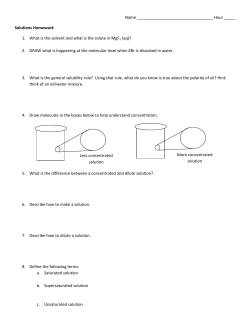
What is the Mole? Hint: Its not a small mammal…
What is the Mole? Hint: Its not a small mammal… The Mole in Chemistry The mole is a unit of measurement in chemistry. The mole is similar to other counting units such as 12 eggs equals 1 dozen. One mole of any substance contains 6.02x10^23 number of particles. (Avogadro's Number) Therefore, one mole of eggs would have 602000000000000000000000 eggs. The mole is a great way to count matter without using really big numbers. This is important for chemistry because there are millions of particles in small amounts of substances The Mole in Chemistry (Cont.) The mole is a great way to count matter without using really big numbers. This is important for chemistry because there are millions of particles in small amounts of substances Just 18 mL (or grams) of water contains 6.02x10^23 molecules of water This presentation will help to explain how we can find out how many moles and molecules are in a given amount of a substance. A Mole of Carbon There are 12 grams in one mole of carbon. All of the other elements mole number is relative to that of carbons. Amazingly, there are 6.02x10^23 atoms in each of the samples above. How to Calculate the Mole A sample of 12 grams of carbon is equal to one mole. The amount of moles in a substance can be determined using that substance’s molar mass. The molar mass is the amount of grams in one mole of a substance. The molar mass is the average atomic mass for a substance. Ex. Carbon has an atomic mass of 12 amu so its molar mass is 12 g/mol Molar Mass The molar mass of an atom, molecule, or compound is the number of grams in one mole of the substance. Molar Mass = Grams/mole Ex. Molar Mass of pure Sodium (Na) Find Sodium on the Periodic Table The molar mass is equal to the atomic mass Therefore, the molar mass is 22.99 or 23.0 grams Calculating Molar Mass for Compounds For compounds, the molar mass is the combined total of all the atomic masses for each atom in the compound. Ex. C6H12O6 There are 6 carbons, 12 hydrogen, and 6 oxygen Carbon has an atomic mass of 12, so we multiply 12 by 6 for a total of 72. We do the same for hydrogen and oxygen and add them all together for the molar mass. C: 6(12) = 72, H: 12(1) = 12, O: 6(16) = 96 So, 72+12+96 = 180 grams/mole You Try! A. B. C. D. What is the molar mass of NH3? 14 g 17 g 4g 25 g Use the Periodic Table Try Again Use this other example of how to calculate molar mass. Try Again Correct!!! Good Answer! Now learn about mole conversions. Mole Conversions Grams have to be converted to moles before converting to number of particles. Grams x 1mol/molar mass = Moles Moles x 6.02x10^23/1mol = Particles Calculating the Moles in a Given Substance Suppose you were given a graduated cylinder with 18 mL of water in it and you were told to find the number of moles. (Hint: 18 mL of water is equal to 18 grams of water) First, we need to find the molar mass for water (H2O) using the average (or relative) atomic masses on the periodic table. 2 H @ 1 g each = 2 g 1 O @ 16 g = 16 g 2 g + 16 g = 18 g of water in 1 mole Second, we set up a conversion factor to convert the grams of water to moles. 18 grams H2O x 1 mole H2O/18 grams H2O (the grams cancel and we are left with moles) = 1 mole of water Calculating Number of Particles from Moles You can convert moles to the number of particles of a substance. Take the number of moles and multiply it by Avogadro’s Number (6.02x10^23) For example, we found that 18 grams of water is equal to 1 mole. 1mole water x 6.02x10^23 particles/mole = 6.02x10^23 particles Let’s Try That Again! Suppose that you have 117 grams of table salt (NaCl). How many particles of salt are present? First, calculate the molar mass (using the average atomic masses on the Periodic Table) Second, convert grams to moles 1 Na @ 23g = 23g 1 Cl @ 23.5g = 35.5g 23g + 35.5g = 58.5g 117g NaCl x 1 mole NaCl/58.5g NaCl = 2 moles NaCl (the grams cancel and you are left with moles) Third, convert moles to particles (using Avogadro's Number) 2 mole NaCl x 6.02x10^23 particles NaCl/1 mole NaCl = 1.2x10^24 particles NaCl Now You Try! If you were given a 78g sample of LiF, how many moles would be present in the sample? Use the Periodic Table. A. 1 mole B. 2 moles C. 3 moles D. 4 moles Calculating Molar Masses Using the Periodic Table •You can find the molar mass of an element by looking at its atomic mass. Here it is located directly under the element symbol and is 107.87. •To find the atomic mass for a compound you just have to count the number of each element and find the atomic mass for each then add them together. •For example, AgO3 is •1 Ag @ 107.87g •3 O @ 16g = 16x3 = 48g •107.87g + 48g = 155.87g •So, there are 155.87g in one mole of AgO3 Not Quite Review the example problem and try again. Correct!!! Great Job! Another Example Problem A. B. C. D. How many moles are in 12 grams of NH3? 1.0 2.5 .71 1.8 Need the Periodic Table? Incorrect Please try again. Yup!!! Good Answer. Now try to convert moles to particles. Try This One How many atoms are present in 2.5 moles of pure sodium? A. 1.5x10^24 B. 1.2x10^23 C. 57.5 D. 135.8 Nope… Try Again! You’re Right!!! Good Work! Final Assessment A. B. C. D. How many particles (molecules) of glucose (C6H12O6) are present in a 270 gram sample? 1.5 9.03x10^23 6.02x10^23 2 Not Quite Remember it’s a two step process. You have to convert grams to moles and then moles to particles. Try Again Great Job! You have learned about the mole and mole conversions!
© Copyright 2025












